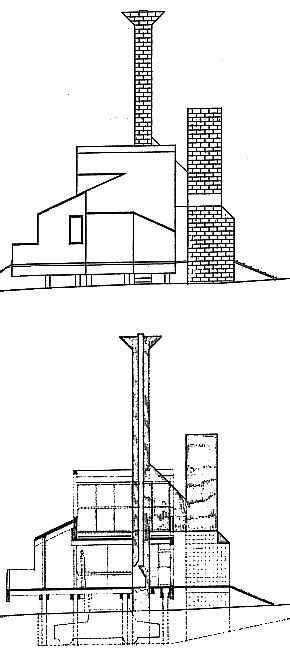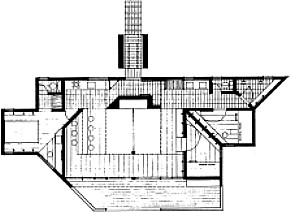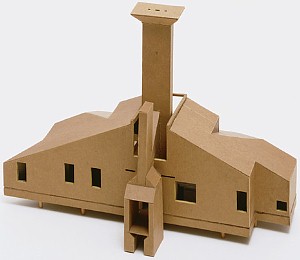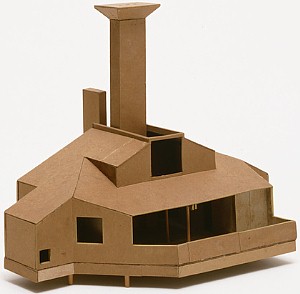

| |
 
| |
2012.07.24 17:21
The Philadelphia School, deterritorialized
Excerpts from the interview with historian David Brownlee:
DB: In any case, what happens in the late '50's is a more palpable historical reference. There is the peculiarity of what I call the Philadelphia corner--the plan form that is sucked in at the corner--the diagonal across the corner (refers to Kahn's Goldenberg house and Venturi's beach house). They are both '59. Now I have to say, on the face of it, this (Goldenberg) is a lot more sophisticated looking design. But that element of design is seen in Mitchell Giurgola's work, and in Vreeland's work. That's a vocabulary that has gone around--it pops up in Kahn's work at this time--Kahn's dorm at Bryn Mawr, and the Richards Medical Building has it sort of implicitly--you enter off the diagonal of a corner…
SR: You see this corner treatment as something specifically about the Philadelphia School?
DB: I do. It all appears about the same time?
SR: Do you think anyone can be identified as being responsible for it? Does Venturi have a hand in it?
DB: I don't know. One of the things I would venture is to say that a more established architect like Kahn--with a formal vocabulary already established--may not be the place where you look for such provocative innovation. It certainly happens--but it is a teasing sort of thing. And another formal trait I see coming in at this time are, what I call another Philadelphia School trait, the big chimneys. They pop up out of the skyline in everybody's work about this time. Those would be places I would look for anything you can in terms of concretely dating 'who does what first.' I have found nothing written that acknowledges or even suggests that kind of influence between the two, having worked through the papers of both. There is not much to go on--Kahn, I think, writes a letter of recommendation for Rome. But that's about it. It has always been said that after the '60s Kahn expressed verbally his respect for Venturi, but said he was unwilling to 'go that far.' He did not follow Venturi's interest into Pop culture. Or, you know, large graphics. Or into the vocabulary of commerce and the strip. And fundamentally, I think, continued to believe in abstraction. He did not believe that buildings required words or intelligible historical references in order to be meaningful. At one point, he said that he 'liked ruins because in ruins the architectural forms had been detached from associated use." They had no denotative meaning left with them anymore, and in that sense continued to be an abstractionist, a modernist of that kind. The things that I see that I can plausibly say are the contributions are some of those stylistic--I won't call them quirks, but they are stylish bits and pieces--and within that, the broader acceptance of things that people could call 'historical' in his work. Now mind you, he was almost always hostile to the notion that anything he did had specific historical references. His willingness to talk about his fondness for history generally, and to speak admiringly of medieval and ancient buildings, never allowed you to draw a connection (that was pretty obvious) between these historical precedents and his work. Whereas Venturi, of course, was underlining that connection wherever possible. Certainly, the younger man's rhetorical style, in using those forms, did not rub off on Kahn at all. But I think the case is plausible that in the period of '54 to '58, as the Philadelphia School was coming together, that some of the distinctive features of it were created by people other than Louis Kahn--although Kahn gets to be their Guru.
Later...
DB: I find it hard to think of Kahn as a mannerist. But I… Maybe the Goldenberg house, which is almost unique; right where you expect the corner to be, there is nothing. [The corner deterritorialized!?]
And from the interview with Robert Venturi and Denise Scott Brown:
SR: Dr. Brownlee was talking about a couple of things he thinks of as being characteristic of the 'Philadelphia School.' One: big chimneys. The other: what he calls the 'Philadelphia corner.' The latter, I think he may have written about--how various architectural historical approaches 'solve the corner problem.' Is that ringing any bells for you?
RV: What does he mean by the corner? Big chimney--actually I think I may have possibly been influenced by Kahn to some extent, but I don't think he ever had a chimney like that. My beach house project, with its big high chimney--never built---horrified Vince Scully. But then also fascinated him at the same time.
DSB: You know, the diagonal was very much Philadelphia School.
RV: Yes. The diagonal. That's right, that diagonal. That, I got from Louis Kahn.
DSB: Well, I know where Lou Kahn got it. He got it from Team Ten. You know, in Europe, there was a lot of thinking about diagonals at that point. Lou had more influence from Team Ten earlier than has been generally recognized. I think I discovered how that happened, too. But that's another story. You know, the conference in Amsterdam in '59 he met Blag Valenca and Aldo Van Eyck. That's how Aldo Van Eyck eventually wound up coming to Penn. [The diagonal reterritorialized!?]
|